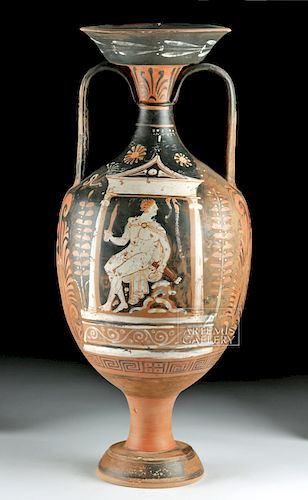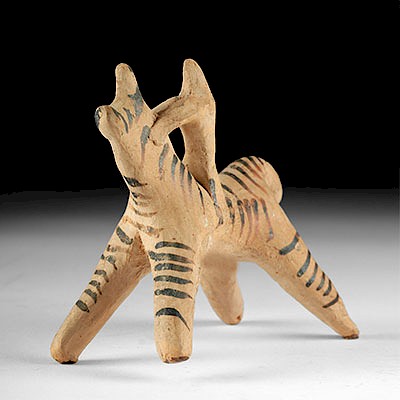Tall Greek Apulian Amphora - Seated Warrior in Naiskos
Lot 38b
About Seller
Artemis Fine Arts
686 S Taylor Ave, Ste 106
Louisville, CO 80027
United States
Selling antiquities, ancient and ethnographic art online since 1993, Artemis Gallery specializes in Classical Antiquities (Egyptian, Greek, Roman, Near Eastern), Asian, Pre-Columbian, African / Tribal / Oceanographic art. Our extensive inventory includes pottery, stone, metal, wood, glass and textil...Read more
Estimate:
$6,000 - $9,000
Absentee vs Live bid
Two ways to bid:
- Leave a max absentee bid and the platform will bid on your behalf up to your maximum bid during the live auction.
- Bid live during the auction and your bids will be submitted real-time to the auctioneer.
Bid Increments
| Price | Bid Increment |
|---|---|
| $0 | $25 |
| $300 | $50 |
| $1,000 | $100 |
| $2,000 | $250 |
| $5,000 | $500 |
| $10,000 | $1,000 |
| $20,000 | $2,500 |
| $50,000 | $5,000 |
| $100,000 | $10,000 |
| $200,000 | $20,000 |
About Auction
By Artemis Fine Arts
Oct 25, 2018
Set Reminder
2018-10-25 11:00:00
2018-10-25 11:00:00
America/New_York
Bidsquare
Bidsquare : Antiquities from Egypt, Greece, Italy, Asia
https://www.bidsquare.com/auctions/artemis-gallery/antiquities-from-egypt-greece-italy-asia-3538
Featuring Egyptian, Greek, Roman, Etruscan, Near Eastern, plus Asian art from Central and Far East. If you love the classics, this is the sale for you. Artemis Fine Arts info@artemisgallery.com
Featuring Egyptian, Greek, Roman, Etruscan, Near Eastern, plus Asian art from Central and Far East. If you love the classics, this is the sale for you. Artemis Fine Arts info@artemisgallery.com
- Lot Description
Magna Graecia, Southern Italy, Apulian, ca. 330 to 320 BCE. An impressive red-figure amphora of a grand scale, presenting a classic form with intriguing iconography and decoration, all finely delineated via the red-figure technique with additional fugitive white, yellow/orange, and red pigments. A remarkable vase of the so-called Ornate Style and an impressively grand scale, decorated with a fine hand to depict intriguing figural scenes (see more discussion about these below) as well as a great deal of subsidiary ornament in added colors. Size: 10.75" W x 24.625" H (27.3 cm x 62.5 cm)
Side A of this amphora features a seated male figure within an Ionic-columnated naiskos. The young man most likely represents a warrior given that he brandishes a sword in his raised right hand and holds the decorative scabbard in his left hand. The youthful male is nude aside from a cloak fastened above his pectorals and cascading over his shoulders, down his back, and below his seated thighs. He is presented in composite profile so that we can admire his muscular physique and full anatomy as well as view his noble profile. Side B presents a pair of draped attendants, standing and facing one another in opposing profiles.
In addition to the figural imagery are the extensive decorative elements. Note the continuous band of laurel leaves beneath the rim created via fugitive white pigment, the black fan palmette and vertical rays on the neck and shoulder above the attendants, and on the opposite side, the red and white flowers, foliage tendrils, and ribbons surrounding the ornamented pediment and Ionic columns of the naiskos. Below the naiskos is a register of dotted swirling motifs, and below the entire painted program is a Greek key band punctuated by three dotted checkerboard motifs that surrounds the lower end of the vessel's body. Finally, beneath the elegant twin handles are large, complex red-figure palmettes.
Virtually no ancient Greek paintings have survived the tests of time. This makes the painted compositions found on ceramic vessels like this example invaluable sources of information about ancient Greek visual art. Refined vases like this amphora were not merely utilitarian pottery, but rather works of art in their own right, highly prized throughout the classical world. Red figure pieces in particular allowed for the development of more naturalistic imagery than black figure examples. This innovative technique involved creating figures by outlining them in the natural red of the vase, making it possible for the painter to then enrich the figural forms with black lines to suggest volume, perspectival depth, and movement, bringing those silhouettes and their environs to life. Beyond this, fugitive pigments made it possible for the artist to create additional layers of interest and detail.
Provenance: private Davis collection, Houston, Texas, USA
All items legal to buy/sell under U.S. Statute covering cultural patrimony Code 2600, CHAPTER 14, and are guaranteed to be as described or your money back.
A Certificate of Authenticity will accompany all winning bids.
We ship worldwide and handle all shipping in-house for your convenience.
#140079Chips to rim and base. Expected surface wear with some pigment loss as shown, but nice remaining painted details. Rim/upper neck/handles reattached. TL hole beneath rim.Condition
- Shipping Info
-
All shipping is handled in-house for your convenience. Your invoice from Artemis Gallery will include shipping calculation instructions. If in doubt, please inquire BEFORE bidding for estimated shipping costs for individual items.
-
- Buyer's Premium



 EUR
EUR CAD
CAD AUD
AUD GBP
GBP MXN
MXN HKD
HKD CNY
CNY MYR
MYR SEK
SEK SGD
SGD CHF
CHF THB
THB


















